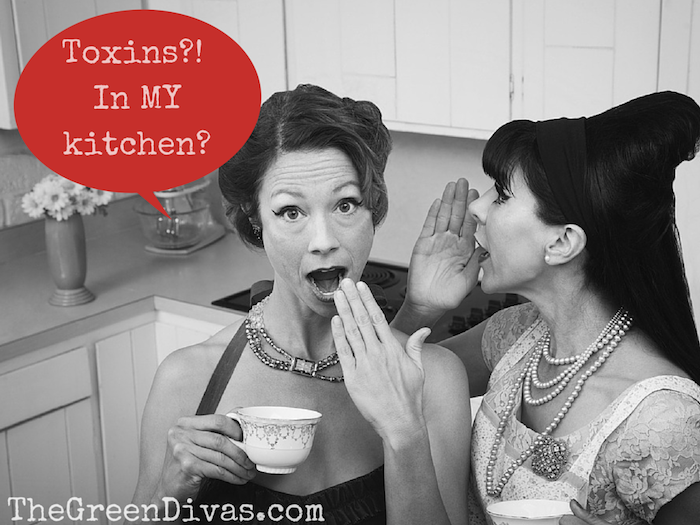
Written by Becky Striepe
Chances are you already do your best to avoid harmful chemicals.
And you probably stock your kitchen with healthy, whole foods.
Still, even with the best intentions we sometimes let common toxic chemicals in food, food packaging, and kitchen cleaning supplies sneak in.
You might think that food safety stops with eliminating harmful food ingredients, but if you really want to avoid chemicals in food, choosing safe packaging and healthy cleaning supplies are just as important.
Here are seven common chemicals that might be lurking in your kitchen:
1. Parabens
Parabens have been getting a lot of attention lately, and with good reason. These toxic ingredients can disrupt hormones and act as a pseudo-estrogen, the latter of which is linked to all kinds of health problems. You might think of parabens as a cosmetics ingredients, but they can also lurk on food labels. Parabens do occur naturally in some foods, like certain berries, but they are different from the chemically-synthesized versions you see on product labels.
How to avoid them: Avoid anything with the word “paraben,” but also look out for PHENOIP, 4-HYDROXYBENZOIC ACID, P-HYDROXYBENZOIC ACID, 4-HYDROXY- ISODECYL ESTER BENZOIC ACID, and BENZOIC ACID
2. Perfluorinated Compounds (PFCs)
This family of chemicals make products resist stains, and you will find them in products from nonstick pans and fast food wrappers to clothing and nail polish. They are a likely carcinogen that are also linked to liver, kidney, and reproductive problems.
How to avoid them: Anything nonstick is suspect. Also be wary of greasy food wrapped in paper—that paper likely contains PFCs, unless you see the grease soaking through. When you’re storing food at home, avoid plastic storage containers.
3. Triclosan
Triclosan is an antibacterial that’s a huge public health concern. Triclosan’s ubiquity is basically a breeding program for superbacteria that’s resistant to antibiotics and antibacterals. It’s in everything from hand soap to deodorant to toothpaste.
How to avoid it: Check your dish soap and cleaning supplies for triclosan, 2,4,4′-trichloro-2′-hydroxydiphenyl ether, 5-chloro-(2,4-dichlorophenoxy)phenol, trichloro-2′-hydroxydiphenyl ether, CH-3565, Lexol 300, and Irgasan DP 300.
4. Fragrance
The trick about “fragrance” on packaging is that it can really be anything. It could be totally harmless, or it could be a known carcinogen. It’s a sneaky way for companies to hide some ingredients under a blanket term for “proprietary reasons.” I used to recommend looking for “free and clear” products to avoid fragrance, but even these sometimes contain fragrance. Reading the ingredients is your best bet.
How to avoid it: Avoid dish soaps and other kitchen cleaning products with “fragrance” or “parfum” on the label.
5. Ethanolamine Compounds
These toxic ingredients work as foaming agents. They can mix with other ingredients to create harmful chemical reactions in your body. The real problem is that since companies don’t have to disclose all of the chemicals they’re using, you can’t make a truly informed buying decision. Look for them in products like dish soap, hand soap, and anything else that foams.
How to avoid them: Look for DEA or Diethanolimine, TEA or Triethanolamine, Cocamide DEA or Cocamide Diethanolimine, Lauramide DEA or Lauramide Diethanolimine, DEA Lauryl Sulphate or Diethanolimine Sulfate, Linoleaide DEA or Linoleaide Diethanolimine, Oleamide DEA or Oleamide Diethanolimine, MEA, linoleamide MEA, and stearamide MEA on product labels.
6. 1,4 Dioxane
This toxic ingredient is a carcinogen used to make products foamier. Think things like soap, bubble bath, and even hair relaxers. Right now, 1,4 dioxane doesn’t have to be labeled, so it’s very hard to avoid in conventional products. Like ethanolamine compounds, any cleaner that foams is suspect, so read those ingredients labels!
How to avoid it: Look for sodium laureth sulfate, sodium lauryl sulfate, PEG compounds, and chemicals that include “xynol,”, “ceteareth,” and “oleth” in the name.
7. Butylated Compounds
Like parabens, these are preservatives used in cosmetics, but food companies also use butylated compounds to prolong shelf life. They are endocrine disruptors linked to organ damage. In fact, the EU has banned butylated compounds in cosmetics. They’re usually found in shelf-stable foods like party mixes or cereal.
How to avoid them: Look for BHA, BHT on the label.
So, how do we avoid these harmful chemicals? You have a few options!
1. Careful label-reading. The front of the package tells you very little about what’s in a product. Flip that puppy over and read the ingredients! Labels like “natural” or “healthy” should be red flags, not comforting phrases.
2. Use your smartphone. Food apps like Edibly can help you make healthier choices by making it easy to look up packaged food before you buy.
3. Avoid processed food. I know. Avoiding all packaged food is a little bit unrealistic. Just do your best to cook from scratch as much as possible, and read those labels when you can’t. Try stocking your kitchen with meals you cook on your days off or going for simple weeknight meals to make it easier on yourself.
4. Go DIY! Try making your own cleaning products. You can even make hand sanitizer from scratch with apple cider vinegar.
Or try this DIY foaming handsoap by Green Diva Meg. ~ Ed.
BONUS:
Listen to this Green Divas Health & Beauty podcast for more tips for avoiding toxins in your products…
Asst Ed ~ Green Diva Christine | Image via Shutterstock.
[dynamic-sidebar id=’Custom Widget 2′]
Pingback: Identifying Toxins At Home Infographic | Care2 Healthy Living